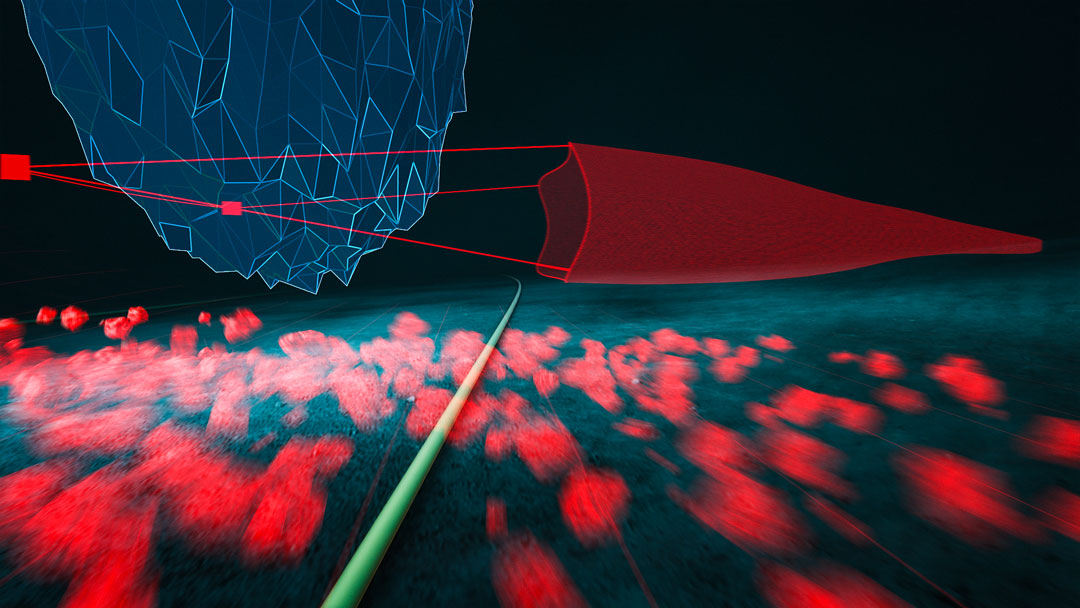The need
The development of subsea fields has required the Oil and Gas industry to go further and deeper as the simpler finds have already been exploited. Field developments are routinely performed at depths of over 2000m, requiring great engineering skills and technologies to be developed likened to seabed factories which are necessary to allow the hydrocarbons to flow without freezing.
Pipeline step-outs from a host facility can reach up to 45Km with the use of trench & bury, chemical injection, trace heating, pipe-in-pipe, and insulation technologies. But the state of the current technology has about reached its maximum as these technologies have been stretched to their limit.
Subterranean Channels
Subterranean Pipelines is a novel use of existing technology that has the potential to change that. By creating Subterranean Channels and placing Pipelines and Well Jumpers within these channels at a depth below seabed where the ambient heat in the subsoil is above the Hydrate formation and Wax Appearance temperatures, will assist the reduction in the formation of these undesired formations which can block the pipes and stop the flow of hydrocarbons.

Less maintenance
Routine maintenance with Pigging is necessary to remove wax build-ups on the pipe wall this requires production to be interrupted. With Subterranean Pipelines the flowing hydrocarbons will be constantly above the Wax Appearance Temperature.
Hydrates form when the hydrocarbons drop below a formation temperature and this can also block the flow. Subterranean Pipelines will maintain the flowing hydrocarbons above the Hydrate formation temperature with no artificial heating, and a much longer shut-in cool-down time. Less chemical Inhibitor injection and less chemical recovery will mean a reduction in FPSO operating costs.
Safer
Pipelines installed using the trench and bury method are prone to damage from fishing activities, dropped objects and other unavoidable hazards. Reports from U.S. Bureau of Safety and Environmental Enforcement and industry statistics indicate that about 2/3rds of oil-spills come from Pipelines, and not Platforms or Wells. More than 937 Pipelines and Well Jumpers were damaged by hurricanes Andrew, Rita and Katrina, and roughly three-quarters of a million gallons of petroleum products was spilled. The age of the Pipelines was reported to be less of an issue than diameter with most spills coming from small bore Pipelines.
Subterranean Pipelines will be fully protected and if any spill did occur, it would be contained within the Subterranean Channel.

Greater flexibility
Subterranean Pipelines will allow field layouts to be more flexible as Wells can be located further from the current maximum 120m from the Manifold which is limited by the capacity of the installation Vessels. With simpler tie-ins to Subsea Trees, rigid Well Jumpers can be eliminated, removing length restrictions and handling/deployment issues in the field, creating CAPEX savings and higher reliability.
Step-out distances can be increased beyond the current 45Km limits ‘un-locking’ previously unreachable ‘probable’ reserves, and helping to maintain production levels at Brown-field sites.
Well drilling distances can be reduced as Wells can be more vertical, if desired, leading to reduced time/cost to drill a Well. The older Drilling Rig fleet can be utilized immediately without expensive upgrades as Subterranean Channels/Pipelines are not in communication with the Well formation. Subterranean Channel construction can start immediately that the field layout is confirmed, leading to fewer issues of combined vessel operations in the Field, and shorten time to first Oil or Gas as metrology can be done before the subsea hardware is installed, and not on the project critical path.
Lower risk
The cost of laying Pipelines and Well Jumpers is enormous and using the current technology leaves Oil companies exposed to unknown costs of seabed preparation, and subsequent changes that occur during the installation period and during the ‘life-of-field’. Not only are there costs and risks associated with the current technology, the current installation methods leave the Pipelines and Well Jumpers difficult to inspect, and in danger of being exposed and unsupported, creating issues such as Vortex shedding and upheaval buckling, and dangers from subsea landslides.
The connections between Subsea Trees and Manifolds known as ‘Well Jumpers’, are a particular environmental and safety concern as they create a greater risk as they are more exposed, and of a smaller diameter than Pipelines and therefore more subject to damage.
The use of Subterranean Pipelines in the construction of a subsea field will mitigate many of these problems, and assist with Pipeline load management, as Pipelines can be axially constrained, leading to smaller Flowline End Termination’s.
Subterranean Pipelines will allow pipeline integrity and corrosion to be monitored in a controlled environment, with no growth problems or buried pipelines requiring removal before inspections, and Subterranean Pipelines will not be exposed to the corrosive effects of salt water.
Reliability
Subsea hardware and downhole Well equipment is designed to be extremely reliable, and loss of Well control does not occur often. If Well controls is lost then it may not be possible to bring the Well under control with the designed intervention equipment known as the Lower Riser or Safety Package and subsea BOP, due to damage to the Subsea Tree. If an intervention is not possible, the last resort is to drill a Relief Well which requires to be drilled from a safe distance. These Relief Wells can take up to 3 months to drill, and require extreme accuracy as the drill path has to intercept with the rogue Well in order to gain communication and allow the Well to be brought under control.
Subterranean Channels will not be in direct communication with the Well during normal production, but in the event of a loss of Well control the existing infrastructure can be used to gain access as the Relief Well is already prepared as part of the field architecture.